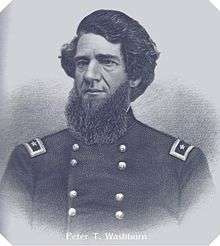Peter T. Washburn
| Peter T. Washburn | |
|---|---|
 | |
| 31st Governor of Vermont | |
|
In office October 15, 1869 – February 7, 1870 | |
| Lieutenant | George W. Hendee |
| Preceded by | John B. Page |
| Succeeded by | George W. Hendee |
| Member of the Vermont House of Representatives | |
|
In office 1853–1854 | |
| Personal details | |
| Born |
September 7, 1814 Lynn, Massachusetts |
| Died |
February 7, 1870 (aged 55) Woodstock, Vermont |
| Political party | Republican |
| Spouse(s) | Almira E. Ferris / Almira P. Hopkins |
| Children | Ferris T. Washburn (1842 - 1860), Emily May Washburn (1846 - 1853), Elizabeth Almira Washburn Worthen (1852 - 1938), Charles H. Washburn (1856 - 1904), Thacher F. Washburn (1859 - 1862) |
| Profession | Attorney / politician |
Peter Thacher Washburn (September 7, 1814 – February 7, 1870) was a lawyer, politician and Adjutant and Inspector General of the State of Vermont during the American Civil War. He was elected Governor of Vermont following the war, and was the first Vermont Governor to die in office.
Early life
Washburn was born September 7, 1814, in Lynn, Massachusetts, the son of Judge Reuben and Hannah Blaney (Thatcher) Washburn of Cavendish, Vermont. His family moved to Vermont in 1817 and settled in Ludlow, Vermont in 1825. He graduated from Dartmouth College in 1835. He studied law under his father in Ludlow, and with William Upham in Montpelier. In 1838 he was admitted to the bar began practicing law in Ludlow in January 1839. In 1844 he moved his practice to Woodstock and formed a partnership with Charles P. Marsh until his death in 1870. He moved to Woodstock in 1844, where he lived for the remainder of his life. In 1844 he was elected reporter of the decisions of the Vermont Supreme Court, a position he held for eight years. He represented Woodstock in the Vermont House of Representatives in 1853 and 1854. He served as chairman of the Vermont delegation to the 1860 Republican National Convention.[1]
Civil War
Washburn had served as Colonel of a Vermont militia regiment from 1837 until 1841, and at the outbreak of the Civil War, he commanded the Woodstock Light Infantry company, which became Company B, 1st Vermont Infantry. He was commissioned Lieutenant Colonel of the 1st Vermont Infantry on May 9, 1861. He commanded the regiment during nearly all of its three months of service at Fortress Monroe and Newport News, Virginia, leading five companies of the 1st Vermont and five from the 4th Massachusetts infantry at the battle of Big Bethel on June 10, 1861. He was mustered out with his regiment on August 15, 1861.
Career
In October 1861, he was elected Adjutant General of Vermont, with the rank of Brigadier General, succeeding Horace Henry Baxter. During his tenure, he sent into the field seven infantry regiments, one cavalry regiment, three batteries of light artillery, two companies of sharpshooters and two companies of frontier cavalry. In 1866, Washburn was succeeded by Brevet Major General William Wells, late of the 1st Vermont Cavalry, as Adjutant General.
Washburn was elected Governor in September 1869, and took office on October 15, 1869.[2] During his tenure, a law was passed providing for biennial rather than annual elections for governor.
Death and legacy
Washburn died on February 7, 1870, apparently of a nervous breakdown.[3] Washburn was twice married, first to Almira E. Ferris of Swanton, VT and second to Almira P. Hopkins of Glens Falls, NY. Two children by his first wife died young, and he had three more children with his second wife who survived his decease. He is interred at River Street Cemetery, Woodstock, Windsor County, Vermont.[4]

References
- ↑ "Peter T. Washburn". The Political Graveyard. Retrieved 23 November 2012.
- ↑ "Peter T. Washburn". National Governors Association. Retrieved 23 November 2012.
- ↑ Linda M. Welch, Dartmouth College, historian of southern Windsor County, Vermont.
- ↑ "Peter T. Washburn". Find A Grave. Retrieved 23 November 2012.
Further reading
- Benedict, G. G., Vermont in the Civil War. A History of the part taken by the Vermont Soldiers And Sailors in the War For The Union, 1861-5. Burlington, VT.: The Free Press Association, 1888.
- Peck, Theodore S., compiler, Revised Roster of Vermont Volunteers and lists of Vermonters Who Served in the Army and Navy of the United States During the War of the Rebellion, 1861-66. Montpelier, VT.: Press of the Watchman Publishing Co., 1892, pp. 5–9, 744.
- Ullery, Jacob G., compiler, Men of Vermont: An Illustrated Biographical History of Vermonters and Sons of Vermont, Brattleboro, VT: Transcript Publishing Company, 1894, part 1, p. 99.
- Waite, Otis F. R., Vermont in the Great Rebellion: Containing historical and biographical Sketches, etc., Claremont, NH: Tracy, Chase, 1869, pp. 256–8.
External links
| Wikimedia Commons has media related to Peter T. Washburn. |
- Inventory of Peter Thacher Washburn Papers, Special Collections, University of Vermont Library
- Vermont in the Civil War
- National Governors Association
- Find A Grave
- The Political Graveyard
| Military offices | ||
|---|---|---|
| Preceded by Horace Henry Baxter |
Vermont Adjutant General 1861–1866 |
Succeeded by William W. Wells |
| Political offices | ||
| Preceded by John B. Page |
Governor of Vermont 1869–1870 |
Succeeded by George W. Hendee |
